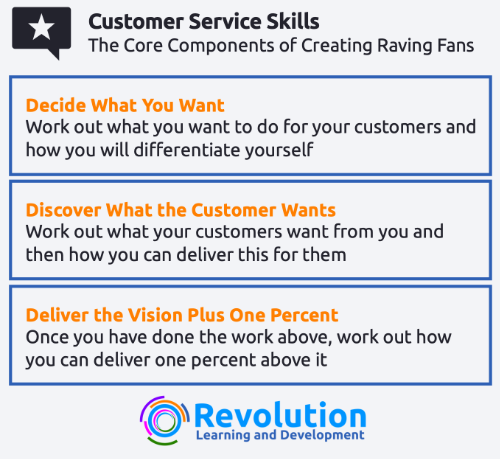What Are You Raving On About?
In this post, we look at raving fans and how to create them for your business.
Have you ever noticed the way stories travel? What is it that makes something worthy of talking about? What is it about a story that means we just can’t help but tell someone else about it?
Uniqueness often plays a role. But in that uniqueness lies the core of our interest… surprise! Surprise points to the difference between expectation and our experience.
Stories are the vehicle for communicating surprise – we want others to experience the same surprise we did, whether that surprise comes as shock, delight, amazement, curiosity, disgust or thoughtfulness. Our storytelling is an attempt to have others think along the same lines as us and, importantly, we want them to feel the way we did. And in recognising both aspects of this, stories become not just about the content, but as the comedian Frank Carson regularly reminded us after telling a joke and making us laugh, “it’s the way I tell ‘em”.
As we’ll see, this points towards to difference between customers talking about you and customers raving about you and turning them into your raving fans. But first the bad news.
Bad News Travels Faster Than Good
Your customers are either talking about you or they’re not. What you want here is obvious, but the question is, if your customers are talking about you, what are they saying and how are they saying it? Hugely important now is, where are they saying it; given the uninhibited power of the internet and social media.
In some ways, the problem organisations face in regard to their service is the age-old one; people are far more inclined to share bad news than good (one only has to see that fake news travels about 6 times faster around the internet than real news to appreciate the imbalance in what is deemed worthy of sharing). Faced head-on though, this problem simply means that good service is not good enough these days. What it takes to have your customers advocating (unsolicited) for your organisation whether through direct word-of-mouth or through the power of their fingers, is doing things so extraordinarily well that they just have to share it with others.
Ironically, in some sectors, just doing things consistently well over time with each and every customer is enough to be extraordinary. But those companies who are serious about creating raving fans should accept that doing things consistently well over time with each and every customer is the starting line and not the goal.
What are Raving Fans?
In the words of Ken Blanchard and Sheldon Bowles in the book of the same title, Raving Fans are those customers who are so overwhelmed or floored by the service they received that they simply can’t stop telling everyone about it.
Raving Fans are not a particular kind of customer. Raving refers mostly to the frequency with which stories are shared and how durable those stories are over time.
When we’ve had an outstanding positive service experience, ‘raving’ means we’re itching to tell someone, anyone, about it.
Raving Fans are one of the best forms of marketing any organisation can have and creating fans who will rave about you might be easier than you think.
The 3 Core Components of Creating Raving Fans

- Decide What You Want
The starting point of developing your customer service strategy or skills is to know what you want. Given the product or service you sell, what are all the aspects of service that you want to offer in relation to it? For example, if you are a hotel business, do you want to take your customer’s baggage to their rooms for them or will that not be part of the service.
Clearly, the service offering around a ‘product’ has a cost and resource implications so you first have to work out what you want to provide and how that will fit with the business model.
You can differentiate yourself from your competitors in both what you offer as well as how you deliver it. If you are responsible for deciding, then it is up to you to ensure that everyone in the organisation knows what is expected. You may then provide guidance (or freedom) as to how they deliver those expectations.
- Discover What the Customer Wants
Once you know what you want, you must work to understand what your customer wants and expects.
For instance, in some hotels, guests will expect that their bags are taken to their rooms for them. Elsewhere it may be considered novel to have this service. Crucial then is asking ourselves questions like; does every customer want a stranger taking their bags away from them – even for reasons of convenience? Do they really want choice? If we offer the service, how will we deliver it given a desire for choice?
More important than reflecting upon this is asking customers themselves; conducting market research, distributing surveys and eliciting feedback from a variety of customers are the usual main steps to be taken. You need to build a picture of what your customers want – you can then place that alongside what you want to offer and map out the customer journeys and experiences that cover both sets of wants. This forms the vision of your service.
- Deliver the Vision Plus One Percent
With a vision in principle, you must now deliver the vision in practice. But not just the vision; the vision plus one percent.
The vision lays down the level of service needed to meet expectations. Plus one percent means to find ways to exceed those expectations. One percent (rather than say ten percent) also reminds us that it is the significance of the act and not the extent that makes the real difference.
7 ways to create Raving Fans
Here are just a few ideas to get you started:
- Contribute to the social and environmental issues your customers care about most.
- Do things a little differently – a cleaning company that hides sweets for the children gets people talking.
- A client we worked with just this week (Mosaic Publicity & Media Training) surprised their workforce by paying for each member of staff to adopt a pony from one of their own client’s as part of a horse-racing themed strategy day. I’m sure the pony sanctuary was blown away by this commitment AND it also brings home the point that employees too are customers business owners serve. It is natural for employees who are raving fans of your organisation to want to create raving fans themselves.
- Go the extra mile – keep looking for ways to surprise and delight your customers
- Be pro-active – anticipate your customer’s needs and show them how you can help them get what they want
- Listen carefully and empathise – this may sound like an expectation of service but those who hone their skills well can tune in to more subtle aspects of behaviour and communication to really uncover and address customer needs and challenges.
There are a thousand different ways in which individuals can act to create raving fans – look carefully at your role and how it impacts customers. Know what the expectations are and then do something worth talking about to exceed them. Why not comment with your best stories and help the raving continue.
How to Keep Your Fans Raving
One of the most commonly cited statistics in business is that it is usually 6 times more costly to find and win a new customer than to re-serve an existing one.
Here’s some ideas to keep your loyal fans raving:
- Reward loyalty
- Thank a returning customer with a special gift
- Pro-actively offer useful industry insights or technology updates
- Invite them to an awards dinner; or
- Simply reach out during challenging times to offer support.
You may need to work harder to keep surprising those who know you well, but this is the basis for ongoing innovation in your service and will challenge those who delight in pleasing others to continually strive for excellence – and who wouldn’t want to rave about that?!
Customer Service Training Course
You can learn more about creating raving fans by attending our customer service training course. See the customer service training course page for more details.




